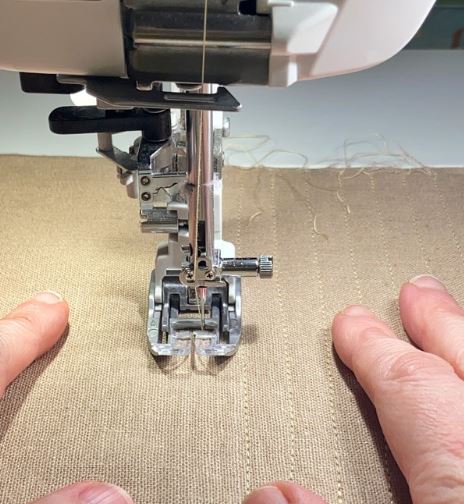
Getting the Most Out of Your Sewing Machine
You may have been using a sewing machine for years … or are brand new to sewing … but here are some things you may not know about your machine!
Photo: Amanda Brown
When you thread your machine, the presser foot should be up so that when you go through the first pass of threading, the tension disks are open and the thread is able to pass between them. Presser foot position is very important. When the presser foot is up, the tension disks are open. When the presser foot is down, it puts tension on those disks to make a good stitch.
When you want to remove your thread, cut it at the spool, then with the presser foot up, pull the thread through the needle. This unthreads the needle, and also removes the thread from the tension discs easily.
Photo: Amanda Brown
Don’t pull on the thread with the presser foot down; tension discs are engaged/closed and this can cause unnecessary wear to the discs. In addition, the thread can break and leave bits of thread stuck in the tension disks. Depending on where the tension discs are on your machine, you may not be able to see that there is anything stuck in there. It can contribute to tension and thread feeding problems.
When you end a seam, pull the fabric piece to the back of the machine instead of the side or front.
Use your automatic thread cutter to reduce the amount of thread you use.
A straight-stitch throat plate has a small round hole for the needle to pass through, allowing less area for the machine to take in or ‘swallow’ the fabric. Use this throat plate for straight stitching.

Photo: Amanda Brown
A standard throat plate has a thin, oblong opening for the needle to pass through. Use this throat plate when making a zigzag stitch and when using a twin needle.
You can adjust the presser foot tension knob according to your fabric. For heavier fabric, you will want less tension so that the fabric slides easily between the presser foot and the feed dogs. For lighter fabrics, you will want more tension, or pressure, so that the presser foot holds the fabric securely to the feed dogs and keeps it from sliding away.
The spool should be turned so that the thread is released counterclockwise.
When you come to the end of the stitching, make sure the take up lever is at its highest position. This will keep the thread from coming out of the needle when you begin to sew.
Changing needles often saves your machine motor. A dull needle will make the motor work twice as hard.
Machine maintenance is a must. Become friends with your sewing machine brush. And your manual!




